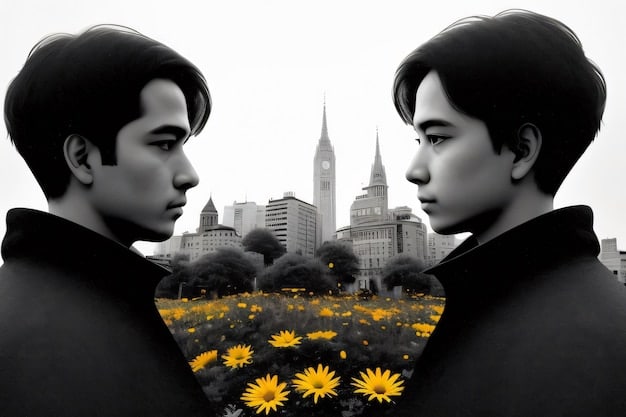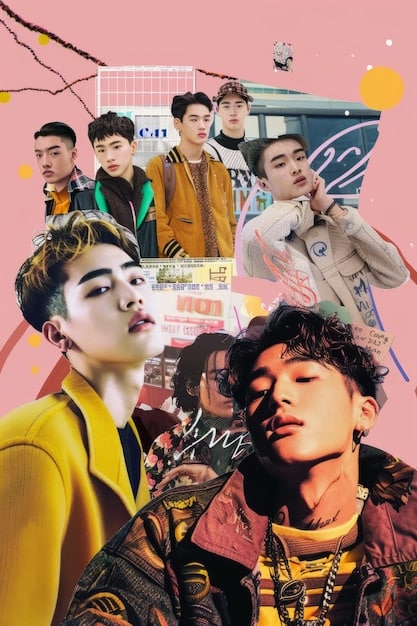The Evolution of K-Drama Soundtracks (2010-2025): A Deep Dive

The Evolution of K-Drama Soundtracks: A Review of the Most Influential Scores from 2010-2025 examines how Korean drama soundtracks have evolved, highlighting pivotal scores, composers, and artists that have shaped the industry and captivated global audiences with their unique blend of musical styles and emotional depth.
Dive into the captivating world of Korean drama music as we explore The Evolution of K-Drama Soundtracks: A Review of the Most Influential Scores from 2010-2025. From heart-wrenching ballads to upbeat pop anthems, discover how these soundtracks have become an integral part of the K-drama experience.
The Rise of K-Drama Soundtracks: Setting the Stage (2010-2015)
The early 2010s marked a significant turning point for K-drama soundtracks. They transitioned from simple background music to integral components of storytelling, enhancing emotional impact and viewer engagement.
During this period, several key trends emerged, shaping the future of K-drama OSTs (Original Soundtracks).
Emergence of Ballads
Heartfelt ballads became a staple, perfectly complementing the often melodramatic storylines. Artists like Baek Ji-young and Gummy dominated the scene with their powerful vocals and emotionally charged performances.
These ballads frequently featured prominently in pivotal scenes, amplifying the emotional intensity and leaving a lasting impression on viewers.
Idol Group Involvement
K-pop idol groups began contributing more frequently to K-drama soundtracks. This crossover not only boosted the popularity of the dramas but also introduced new audiences to K-pop.
Groups like SHINee, Girls’ Generation, and 2PM lent their voices to various dramas, creating catchy and memorable tracks.
- “That Woman” (Secret Garden): Sung by Baek Ji-young, this ballad is a perfect example of the emotional depth K-drama soundtracks achieved during this era.
- “Someday” (Dream High): IU’s rendition showcases the blend of idol power with poignant storytelling.
- “Best Love” (Best Love): A collaboration featuring various artists, capturing the romantic essence of this popular drama.
- “It Has to Be You” (Cinderella’s Sister): Yesung of Super Junior delivered a powerful ballad that resonated deeply with audiences.
This initial period laid the groundwork for the more sophisticated and diverse soundtracks that would follow in later years, solidifying the connection between music and drama.

Diversification and Genre Blending (2015-2020)
As K-dramas gained international recognition, their soundtracks evolved to include a wider range of genres and styles. This period saw a significant diversification, moving beyond traditional ballads to incorporate pop, R&B, and even indie influences.
This diversification was driven by innovative composers and producers who sought to create soundtracks that were not only emotionally resonant but also sonically diverse.
Indie Music Infusion
Indie artists began making their mark on K-drama soundtracks, bringing a fresh and alternative sound to the scene. Artists like Heize and 10cm added a unique flavor to dramas, appealing to a broader audience.
Their contributions often provided a refreshing contrast to the typical pop and ballad-dominated landscape.
Instrumental Scores Taking Center Stage
Instrumental scores started playing a more prominent role, creating atmosphere and tension in dramas. Talented composers like Kim Jun-seok and Park Se-joon crafted intricate and evocative scores that enhanced the viewing experience.
These instrumental pieces often became iconic in their own right, recognized and loved by fans for their ability to evoke specific emotions and memories.
- “Round and Round” (Goblin): A collaboration between Heize and Han Soo-ji, blending dreamlike vocals with a haunting melody.
- “Stay With Me” (Goblin): Chanyeol of EXO and Punch created a duet that resonated with fans worldwide, becoming one of the most iconic K-drama OSTs.
- “Everytime” (Descendants of the Sun): Chen of EXO and Punch gave a memorable and catchy track that became a chart-topper.
- “Don’t Forget” (Moon Lovers: Scarlet Heart Ryeo): Sung by Davichi, creating a powerful song that captured the themes of love and loss, resonating with audiences for its emotional depth.
Genre blending added depth and complexity to K-drama soundtracks, making them more engaging and appealing to a global audience. The boundaries of what a K-drama OST could be were stretched during this period.
Global Impact and Cross-Cultural Collaborations (2020-2025)
The globalization of K-dramas led to increased international collaborations and a greater emphasis on appealing to diverse audiences. Soundtracks became more globally influenced, featuring collaborations with Western artists and incorporating various international musical styles.
Streaming platforms facilitated the accessibility of K-dramas and their soundtracks, contributing to their widespread popularity.
Collaborations with International Artists
Collaborations with Western artists became more common, blending K-pop sensibilities with international musical trends. These collaborations often resulted in hybrid tracks that appealed to a broader global audience.
Notable examples include collaborations with artists from the US, Europe, and Latin America.
Soundtracks as Standalone Hits
K-drama soundtracks gained recognition as standalone hits, often topping music charts and receiving awards in their own right. This recognition further solidified the importance of soundtracks in the overall success of K-dramas.
Several songs transcended their original context to become global hits, demonstrating the power of K-drama music.

- “Sweet Night” (Itaewon Class): V of BTS showcased his warm vocals in this soothing and reflective song.
- “Future” (Start-Up): Red Velvet presented encouraging theme song with their uplifting vocals.
- “Here I Am Again” (Crash Landing on You): Yerin Baek provided one of the series’ most impactful and memorable songs with her vocals.
- “Yours” (Jirisan): Jin of BTS conveyed emotion in this beautiful song which left many fans deeply engaged because of his signature vocals.
These global collaborations and the recognition of soundtracks as standalone hits demonstrate the growing influence and reach of K-drama music on the world stage. K-drama soundtracks have evolved into a cultural phenomenon.
Technological Advances and Music Production
Technological advancements in music production have significantly influenced the evolution of K-drama soundtracks. The use of digital tools, virtual instruments, and sophisticated mixing techniques has allowed composers and producers to create increasingly complex and immersive soundscapes.
These advancements have not only diversified the sound of K-drama OSTs but also enhanced their emotional impact and storytelling capabilities.
Digital Audio Workstations (DAWs)
DAWs have become essential tools for composing and producing K-drama soundtracks. These software programs allow composers to create, edit, and mix music with unprecedented precision and flexibility.
Popular DAWs like Ableton Live, Logic Pro, and Cubase offer a wide range of features and plugins that enable composers to craft unique and innovative soundscapes.
Virtual Instruments and Sample Libraries
Virtual instruments and sample libraries have revolutionized the creation of K-drama soundtracks. These digital resources provide composers with access to a vast array of sounds, from orchestral instruments to electronic synthesizers, allowing them to create rich and diverse musical textures.
High-quality sample libraries capture the nuances and subtleties of real instruments, providing a level of realism that was previously unattainable.
- Advanced Mixing Techniques: Modern mixing techniques, such as multi-band compression, equalization, and spatial processing, have allowed engineers to create more balanced and immersive soundscapes.
- Mastering for Streaming Platforms: Mastering techniques have evolved to optimize K-drama soundtracks for streaming platforms, ensuring that they sound their best on a wide range of devices.
- Automation and Dynamic Control: Automation features in DAWs allow composers to create dynamic and evolving soundscapes that respond to the narrative and emotional cues of the drama.
- Collaboration Tools: Cloud-based collaboration tools enable composers, producers, and musicians to work together remotely, streamlining the production process and fostering creativity.
Therefore, technological advances have enabled the development of K-drama scores that complement visual storytelling and raise audience experience beyond what was previously possible.
The Role of Composers, Singers, and Production Companies
Composers, singers, and production companies play crucial roles in shaping the evolution of K-drama soundtracks. Their creativity, vision, and expertise determine the quality and impact of the music, influencing the overall success of the dramas.
Each element must work together effectively to create sound output that suits the message.
Notable Composers
Composers are responsible for crafting the musical scores that underscore the emotional and dramatic elements of K-dramas. They create melodies, harmonies, and arrangements that enhance the storytelling and evoke specific feelings in the audience.
Some very talented composers have been key to the rising of K-dramas, including those who are talented at blending new styles with established ones.
Iconic Singers
Singers bring the lyrics and melodies to life, imbuing the songs with their unique vocal styles and emotional interpretations. Their performances often resonate deeply with audiences, creating lasting impressions and iconic moments in K-drama history.
The ability of a singer to draw in and resonate with the audience frequently decides a song’s success.
- Consistent Quality: Production companies must maintain consistent quality across all aspects of soundtrack production, from composition and recording to mixing and mastering.
- Talent Development: Production companies invest in talent development, identifying and nurturing promising composers, singers, and musicians.
- Marketing and Promotion: Production companies play a crucial role in marketing and promoting K-drama soundtracks, ensuring that they reach a wide audience and receive the recognition they deserve.
- Collaboration and Partnerships: Production companies foster collaboration and partnerships between composers, singers, and other creative professionals, creating a synergistic environment that promotes innovation and creativity.
The combined efforts of composers, singers, and production companies have elevated K-drama soundtracks to new heights, making them an integral part of the global K-drama phenomenon. Effective collaboration is the basis of success as K-dramas continue their evolution.
Future Trends in K-Drama Soundtracks
As K-dramas continue to evolve and gain global popularity, their soundtracks are expected to undergo further transformations. Several emerging trends and innovations are likely to shape the future of K-drama music, offering exciting opportunities for composers, singers, and fans alike.
These improvements are expected to push the standards for what K-dramas can give listeners.
Virtual Reality and Immersive Sound Experiences
Virtual reality (VR) and immersive sound technologies have the potential to revolutionize the way audiences experience K-drama soundtracks. VR experiences could transport viewers into the world of the drama, allowing them to immerse themselves fully in the story and music.
Immersive sound technologies, such as Dolby Atmos and spatial audio, could create a more three-dimensional and engaging listening experience, enhancing the emotional impact of the music.
Artificial Intelligence in Music Composition
Artificial intelligence (AI) is increasingly being used in music composition, offering new tools and possibilities for composers. AI algorithms can generate melodies, harmonies, and arrangements, assisting composers in the creative process and enabling them to explore new musical ideas.
AI can also be used to personalize K-drama soundtracks, tailoring the music to individual viewers’ preferences and emotional states.
- Interactive Soundtracks: K-drama soundtracks could become more interactive, allowing viewers to control the music and sound effects in real-time.
- Personalized Music Recommendations: AI-powered music recommendation systems could suggest K-drama soundtracks based on viewers’ listening habits and emotional preferences.
- Live Performances in the Metaverse: K-drama singers and musicians could perform live in virtual environments, allowing fans from around the world to attend concerts and interact with their favorite artists.
- Blockchain and Music Ownership: Blockchain technology could be used to create new models for music ownership and distribution, allowing composers and singers to retain greater control over their work and revenue streams.
The future of K-drama soundtracks promises to be dynamic and innovative, with technological advancements and creative collaborations pushing the boundaries of what is possible. As K-dramas continue to evolve, their soundtracks are likely to play an increasingly important role in shaping the global entertainment landscape.
| Key Aspect | Brief Description |
|---|---|
| 🎵 Early Ballads | Emotional ballads set the tone in early K-Drama soundtracks. |
| 🌟 Idol Involvement | K-Pop idols boost drama popularity with catchy songs. |
| 🌍 Global Impact | International collaborations widen audience reach. |
| 🤖 Tech Advances | Technology enhances sound complexity and viewer experience. |
FAQ
▼
K-Drama soundtracks blend diverse musical genres, powerful emotional ballads, and integrate storytelling. They often feature collaborations with popular K-pop artists, offering a unique fusion of visual and auditory elements enhancing drama and appeal.
▼
Idol groups have infused K-Drama soundtracks with catchy, upbeat tunes, attracting younger audiences and broadening each drama’s reach. Their participation has elevated the popularity and commercial appeal of soundtracks, increasing international fan engagement.
▼
Composers create the musical scores that support a drama’s key emotional and dramatic themes. They develop melodies, harmonies, and arrangements that effectively underscore scenes, enhancing the storytelling and viewer emotional experiences.
▼
Future soundtrack trends include VR experiences that immerse viewers in drama settings and AI for personalized music. Immersive sound tech should make the viewer experience better, as well, for those watching dramas.
▼
K-Drama OSTs are recognized globally due to the cross-cultural appeal of their melodies and heartfelt lyrics. The combination of captivating music with internationally watched dramas supports their success and popularity, which goes beyond language barriers.
Conclusion
The evolution of K-Drama soundtracks from 2010 to 2025 highlights a transformative journey marked by diversification, technological advancements, and global collaborations. What began as simple background music has blossomed into a dynamic and influential art form, enriching the viewing experience and captivating audiences worldwide. This is a testament to the innovation and creativity of the composers, singers, and producers who have shaped the course of K-Drama music.





